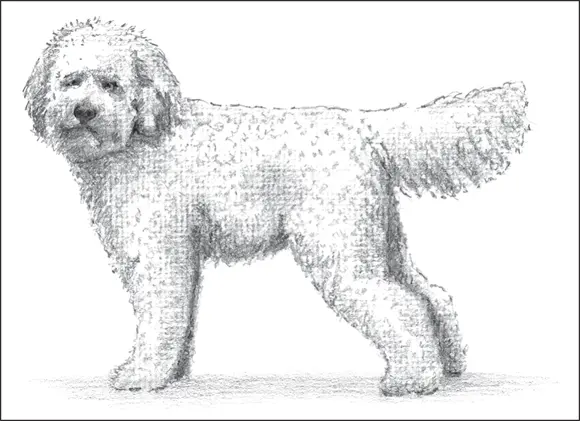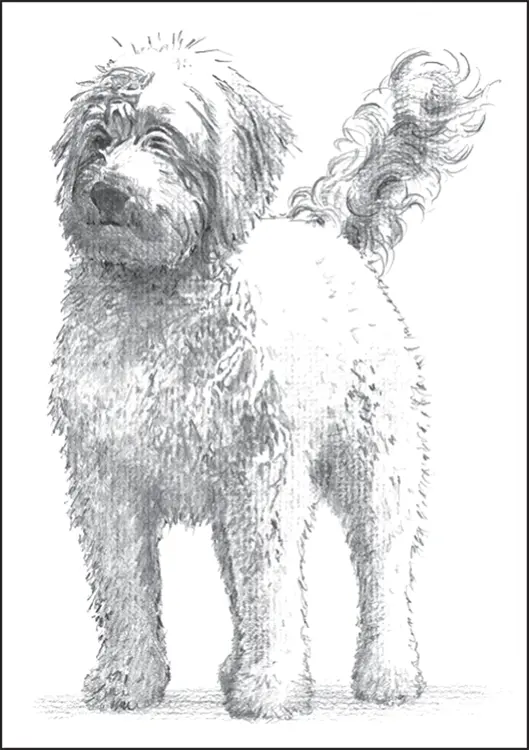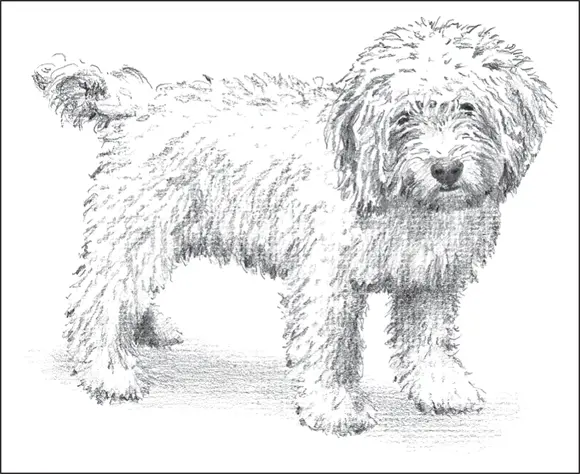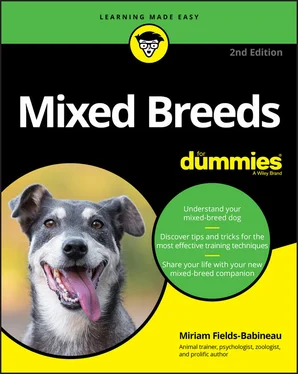As much as the breeders of designer dogs claim that mixing two breeds improves the offspring’s overall health, that fact is debatable. Although many of the puppies don’t show symptoms of the recessive genetic dysfunctions commonly seen in purebred dogs, many other puppies do. In fact, a hybrid puppy can have the poor luck to inherit the worst physical and temperament traits of both parents.
 There are no guarantees when you get a dog — purebred, hybrid, or mutt.
There are no guarantees when you get a dog — purebred, hybrid, or mutt.
The Major “Labels” in the Designer-Dog World
In the following sections, I introduce you to some of the most popular designer dogs.
 I can’t cover all 200+ varieties of designer dogs in this chapter. But if you’re curious about the wide variety of designer dogs available, a great resource is the American Canine Hybrid Club (
I can’t cover all 200+ varieties of designer dogs in this chapter. But if you’re curious about the wide variety of designer dogs available, a great resource is the American Canine Hybrid Club ( www.achclub.com ). Click the Breeds tab to see a list of all the breeds the club recognizes.
Few hybrids are more popular than those with a Poodle parent. In fact, it was the Poodle mixture that started the entire fad of designer dogs, beginning with the Labradoodle and Cockapoo.
Poodles bring many great attributes into the hybrid crossing, plus they come in four sizes: Standard, Miniature, Toy, and Teacup (a size not currently recognized by the AKC). Plus, they’re low- to no-shed dogs with dirt-resistant coats. When combined with a Retriever, or other straight soft-coated breed, they can produce a beautiful wavy or large-curl coat that’s very attractive.
The smaller Poodle breeds also tend to live a long time. So instead of having a dog for only 10 to 12 years, you’ll have one who will live upwards of 15 years. That, alone, makes a Poodle mix very attractive.
When compared to other purebred dogs, Poodles are rated high on the intelligence scale. They learn quickly and can work their way through problems faster than most other breeds. What’s not to like about fast housetraining? Poodles are sensitive, highly aware, and learn by watching others.
Unless very poorly bred, Poodles have few genetic defects, though they aren’t totally without health concerns. Their hips are far better than most retriever and shepherd breeds. They aren’t prone to heart problems seen in many types of dogs. And they rarely have epilepsy, retinal atrophy, or allergies. Overall, mixing any purebred dog with a Poodle will create great offspring.
Labradoodles (Labrador Retriever/Poodle)
Created as the ultimate service dog, Labradoodles (see Figure 2-1) quickly became popular around the world. Just as the Labrador Retriever is the most popular purebred dog in the United States, the Labradoodle is also the most popular, large designer dog.

Illustration by Barbara Frake
FIGURE 2-1:Labradoodles have three coat types, two of which do shed.
Initially, Labradoodles were bred to aid people who needed service dogs, but were allergic to dog dander and fur. Labradoodles are large, solid, strong, and intelligent. They’re eager to learn and love to please their human companions. As with the purebred Labrador service dogs, Labradoodles can work all day without tiring. And they’re very loving. Labradoodles are ideal with children.
 Labradoodles don’t interact well with assertive people or dominant dogs. Any heavy-handed training technique, such as being yelled at or jerked around on a leash, will cause a Labradoodle to shut down and want to crawl into a corner.
Labradoodles don’t interact well with assertive people or dominant dogs. Any heavy-handed training technique, such as being yelled at or jerked around on a leash, will cause a Labradoodle to shut down and want to crawl into a corner.
Goldendoodles (Golden Retriever/Poodle)
Goldendoodles (see Figure 2-2) turn an already perfect family pet into a perfect family pet that sheds less. The mixing of the Golden Retriever and Poodle changes little about the offspring other than coat appearance. The majority of Goldendoodles have coats with golden hue, the structure generally similar to that of the retriever. But the coat changes from a long and smooth, sometimes wavy texture, to a scruffier, curlier, harsher texture.

Illustration by Barbara Frake
FIGURE 2-2:Goldendoodles are a great combination of two great family dogs.
Golden Retrievers are the ideal dog — they love to please their human companions, play ball, cuddle, play ball, go for long walks, play ball, fetch a stick in the water, or if you’re feeling like you want to play fetch for hours, fetch the ball in the water. They’re easy to train and easy to care for.
They’re energetic and playful outdoors and happy to rest at your feet or join in a quiet game indoors. Many will bark to let you know of visitors, though they don’t believe in strangers — after all, anyone can throw a ball.
Cockapoos (Cocker Spaniel/Poodle)
In Cockapoos (see Figure 2-3), generally the Poodle is the sire (father), and the Cocker Spaniel is the dam (mother). Adult Cockapoos mature from 10 to 30 pounds depending on the size of the parents (mainly the size of the sire) and the gender of the puppy. Their coat grows very long and sheds very little, if at all. Cockapoos require grooming every two to four months depending on the desired length of hair. This hybrid is excellent for families with allergies or asthma. They come in a variety of colors: buff, red, chocolate, black, white, and a variety of parti-colors.

Illustration by Barbara Frake
FIGURE 2-3:Cockapoos are great medium-sized dogs that shed very little, love to cuddle, and learn quickly.
Cockapoos are very patient and tolerant with children, and because they like to play and are durable, children like them. They may bark to alert you of intruders, but they rarely go beyond making noise — especially once the person is allowed inside.
Some Cockapoos can be very sensitive because both parent breeds have a tendency toward having their feelings hurt very easily. This is a great hybrid for the elderly, because Cockapoos are gentle, cuddly, and easy to care for.
Schnoodles (Miniature Schnauzer/Poodle)
Schnoodles (see Figure 2-4) are very loyal to their families. This hybrid is affectionate, extremely intelligent, easily trained, clever, friendly, fun loving, and loaded with personality! However, because they are half Schnauzer, they can also be willful, stubborn, and prone to excessive barking. Most Schnoodles are good with children and get along fine with other animals. They’re great watchdogs because they let you know when someone is near, but they aren’t aggressive.
This great companion dog excels in obedience, agility, and flyball. They make excellent therapy dogs. Schnoodles are loyal and loving companions. They’re comfortable in any environment — from an apartment to a farm — as long as they’re with their families.
Читать дальше

 There are no guarantees when you get a dog — purebred, hybrid, or mutt.
There are no guarantees when you get a dog — purebred, hybrid, or mutt. I can’t cover all 200+ varieties of designer dogs in this chapter. But if you’re curious about the wide variety of designer dogs available, a great resource is the American Canine Hybrid Club (
I can’t cover all 200+ varieties of designer dogs in this chapter. But if you’re curious about the wide variety of designer dogs available, a great resource is the American Canine Hybrid Club ( 
 Labradoodles don’t interact well with assertive people or dominant dogs. Any heavy-handed training technique, such as being yelled at or jerked around on a leash, will cause a Labradoodle to shut down and want to crawl into a corner.
Labradoodles don’t interact well with assertive people or dominant dogs. Any heavy-handed training technique, such as being yelled at or jerked around on a leash, will cause a Labradoodle to shut down and want to crawl into a corner.












